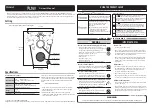
TopClean S CPC 30
6 Commissioning
Hauser
55
The following diagram shows the schematic structure of the CPM 153 controller.
Because of the simplicity of the diagram, the Laplace transform of subfunctions is given.
Fig. 23: Schematic diagram of the CPM 153 controller with K
R
(X) as the total gain
Range-dependent modulation gain
The majority of pH neutralisation processes are strongly non-linear (Example: titration
curve). If you specify a strong alkali in portions to a fixed volume of a weak acid, the pH
value changes. The change in pH value is, at the beginning, relatively small, larger in
the area of the so-called equivalence point and then ever smaller.
In the following diagram, such a titration curve is represented for a weak acid with a
strong alkali (y axis: pH value, x axis: volume units added to a strong alkali).
Fig. 24: Schematic titration curve of a weak acid with a strong alkali.
For difficult neutralisations, the CPM 153 controller gives you the option of partial
compensating for the non-linearity by entering an inverse characteristic curve Y(X).
X
Actual value
W
Set point
E
Control difference
Y
Actuating variable
K
R
Modulation gain (total gain)
T
n
Integral action time (I component)
T
v
Derivative action time (D component)
X
W
E
Y
I
P
D
K (X)
R
*
T *S
v
1/(T *S)
n
1
+
+
+
–
+
C07-CPM153xx-05-06-xx-xx-001.eps
pH
X [ml NaOH]
5
6
7
8
9
10
11
12
5
10
15
20
25
30
35
C07-CPM153xx-05-06-00-xx-008.EPS
















































